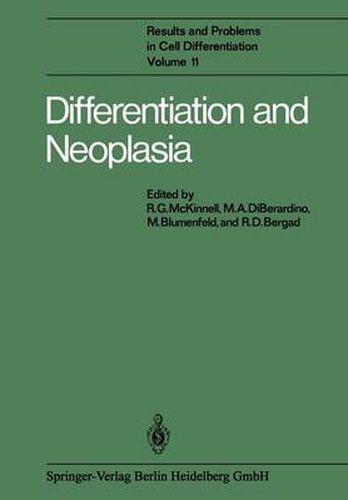Readings Newsletter
Become a Readings Member to make your shopping experience even easier.
Sign in or sign up for free!
You’re not far away from qualifying for FREE standard shipping within Australia
You’ve qualified for FREE standard shipping within Australia
The cart is loading…






This title is printed to order. This book may have been self-published. If so, we cannot guarantee the quality of the content. In the main most books will have gone through the editing process however some may not. We therefore suggest that you be aware of this before ordering this book. If in doubt check either the author or publisher’s details as we are unable to accept any returns unless they are faulty. Please contact us if you have any questions.
There is no commonly accepted mechanism to explain differentiation of either normal or neoplastic cells. Despite this fact, the organizers of the 3 rd International Conference on Differentiation recognized that there is much emerging evidence which supports the view that both normal cells and many cancer cells share common differentiative processes. Accordingly, the organizers perceived that clinical scientists and developmental biologists would greatly benefit by together considering differentiation. In that way, developmental biologists would be apprised of recent insights in cancer cell biology and the physician scientist would be updated on events in developmental biology and both would gain new understanding of the cell biology of neoplasia. A specific example may reveal the potential value of developmental biologists interacting with cancer physicians. An example chosen at random suggests that probably any paper included in the symposium volume would serve the purpose. Dr. Stephen Subtelny reviewed recent studies by his laboratory concerning germ cell migration and replication in frog embryos. How might those results interest the cancer scientist? Dr. Subtelny showed that primordial germ cells of a fertile graft will reverse their migratory direction and move into a sterile host. Perhaps in this context it would not be inappropriate to state that the germ cells of the graft metastasized into the host. Germ cells from grafts of a different species will populate the previously sterile host gonad.
$9.00 standard shipping within Australia
FREE standard shipping within Australia for orders over $100.00
Express & International shipping calculated at checkout
This title is printed to order. This book may have been self-published. If so, we cannot guarantee the quality of the content. In the main most books will have gone through the editing process however some may not. We therefore suggest that you be aware of this before ordering this book. If in doubt check either the author or publisher’s details as we are unable to accept any returns unless they are faulty. Please contact us if you have any questions.
There is no commonly accepted mechanism to explain differentiation of either normal or neoplastic cells. Despite this fact, the organizers of the 3 rd International Conference on Differentiation recognized that there is much emerging evidence which supports the view that both normal cells and many cancer cells share common differentiative processes. Accordingly, the organizers perceived that clinical scientists and developmental biologists would greatly benefit by together considering differentiation. In that way, developmental biologists would be apprised of recent insights in cancer cell biology and the physician scientist would be updated on events in developmental biology and both would gain new understanding of the cell biology of neoplasia. A specific example may reveal the potential value of developmental biologists interacting with cancer physicians. An example chosen at random suggests that probably any paper included in the symposium volume would serve the purpose. Dr. Stephen Subtelny reviewed recent studies by his laboratory concerning germ cell migration and replication in frog embryos. How might those results interest the cancer scientist? Dr. Subtelny showed that primordial germ cells of a fertile graft will reverse their migratory direction and move into a sterile host. Perhaps in this context it would not be inappropriate to state that the germ cells of the graft metastasized into the host. Germ cells from grafts of a different species will populate the previously sterile host gonad.